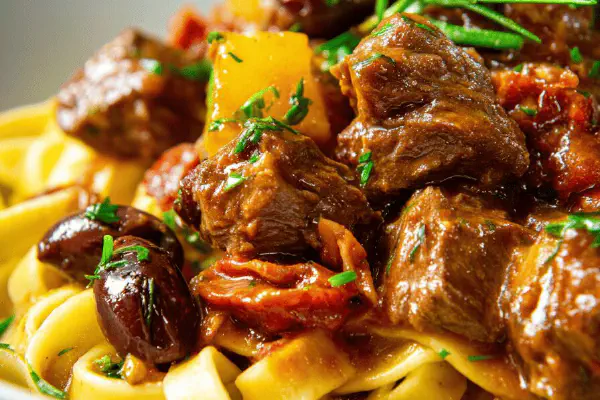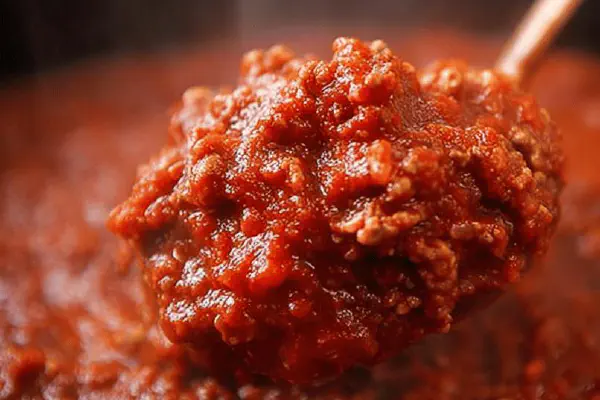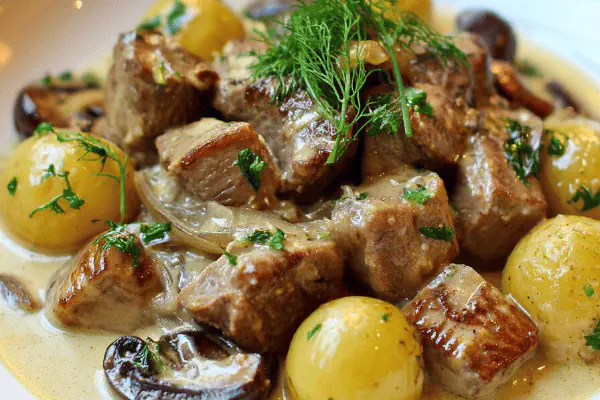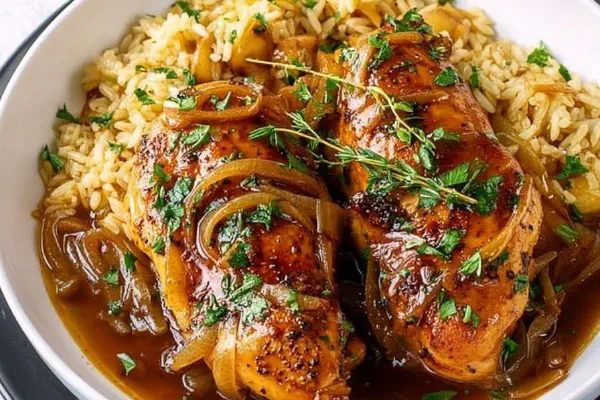Slow Cooker Beef Daube Revival

By Emma
Certified Culinary Professional
Ingredients
- 700 g beef stew meat, cut into large chunks
- 300 ml peeled parsnip pieces, about 1 inch
- 400 ml cubed red-skinned potatoes, medium size
- 200 ml chicken stock (can use vegetable stock)
- 200 ml dry red wine, preferably robust
- 150 ml kalamata olives, pitted and halved
- 100 g smoked chorizo, diced small
- 3 plum tomatoes, roughly chopped
- 3 cloves garlic, minced
- 1 shallot, thinly sliced
- 8 ml herbes de provence, fresh if possible
- 1 bay leaf
- Small pinch of ground allspice
- Sea salt and cracked black pepper to taste
About the ingredients
Method
- Toss beef chunks in the ceramic slow cooker dish. Peeling the parsnip helps cut bitterness; add them next along with potatoes for variety in texture and earthiness.
- Mix in tomatoes, garlic, and sliced shallot, they'll soften and sweeten the broth as it cooks.
- Pour in red wine and chicken stock carefully, enough liquid to almost cover but not drown everything. All about layers, not drowning the flavors.
- Sprinkle the herbes de provence, bay leaf, and tiny pinch allspice. The allspice imitates cloves but less aggressive, this subtle switch lets the chorizo shine.
- Introduce kalamata olives at this point along with diced smoked chorizo instead of bacon; the fat renders down adding sharp, smoky depth, richer and less salty than pancetta. Rest assured, both olives and meat need minimal prep — quick rinse olives; chorizo sliced thin to distribute flavors.
- Salt and pepper only lightly here. Over-salting early crushes the beef’s natural juice.
- Cover the slow cooker; cooked roughly 7 hours on low heat or 5 hours on high if short on time. Low and slow breaks down collagen just right. You’ll see foaming start around 3 hours — skim if too foamy, but often it settles back.
- Testing done best by fork-prodding beef for tenderness. Should flake easily but not mush. Sauce thickens from natural juices and evaporates slowly to rich consistency, stirring midway if you’re nearby.
- Remove bay leaf before serving. Adjust seasoning at the end — this is when salt and pepper count, add cautiously.
- Serve with tagliatelle tossed in olive oil or varnished with butter for those who eat dairy. Alternative: gluten-free pasta or rustic bread to soak up juices.
Cooking tips
Chef's notes
- 💡 Start with well cut beef chunks, fat distribution impacts final sauce. Toss with salt pepper first, some juice released early. Parsnips add subtle sweetness and texture, swap carrots agreed but keep chunk size consistent for even cook. Potatoes medium cubed for starch, absorbs flavors; mind not to overdo or they fall apart.
- 💡 Layer flavors gradually. Tomatoes chopped but not mush, keep their shape. Garlic crushed lightly, not paste; releases punchy aroma without bitterness. Shallot thin slices soften into the broth over time, smooths edges. Pour wine and broth slowly, helps deglaze pan base. Avoid drowning flavors, just enough to cover meats and veg.
- 💡 Herbs minimal: fresh herbes de provence if possible, dry works but punch less. Bay leaf and pinch ground allspice replace typical clove note, gentler warmth to let chorizo stand out. Chorizo diced very thin to spread smoky fat evenly, skips greasier pockets. Kalamata olives rinsed quickly, remove excess brine but keep that bold edge; adds fruitiness against red wine acidity.
- 💡 Early salting light only, over salting crushes beef moisture. Salt last near end, taste often, adjust cautiously. Slow cooker foams early around 3 hours, skim if dense or just leave if thin layer edges off. Stir mid way helps sauce thicken naturally, no flour needed; patience key for texture shift from liquid to glossy coat on meat.
- 💡 Test doneness by fork probe; beef should flake but not mush. Visual cues: bubbles slow from foam to gentle simmer, aroma deepens, fat softly shimmering on surface. Remove bay leaf before plating. Pair with tagliatelle or bread to mop sauce; olive oil finish suits dairy-free but butter adds richness if allowed. Timings flexible but do not rush, texture beats clock.
Common questions
Why replace carrots with parsnips?
Parsnip tougher flavor, sweeter, less mushy if sized right. Adds earthiness not found in carrot. Experimented multiple times; carrots overshadow delicate balance. Parsnip stays firm longer but softens eventually; better for this slow braise method.
Can I use regular black olives?
Yes but kalamata bring sharper fruit note, darker color contrast. Black olives oily and mild, might fade against wine. If no kalamata, rinse black thoroughly and maybe add extra herbs to punch up flavor. Olive type shifts profile quite a bit so account for that.
Sauce too thin what to do?
Keep lid on mostly but stir midway. If too loose near end, remove lid last 30 minutes to reduce liquid. Patience on slow simmer needed. For quicker fix, small sprinkle of cornstarch slurry, but dissolves original intention of natural thickening. Watch texture cues: shine not watery.
How best to store leftovers?
Fridge fine 3-4 days, seal tight avoids odor pull. Freeze in airtight container, portioned if possible, defrost slowly overnight. Reheat gently on low, stirring helps revive sauce. Pasta and bread best fresh; dry noodles soak differently next day.



